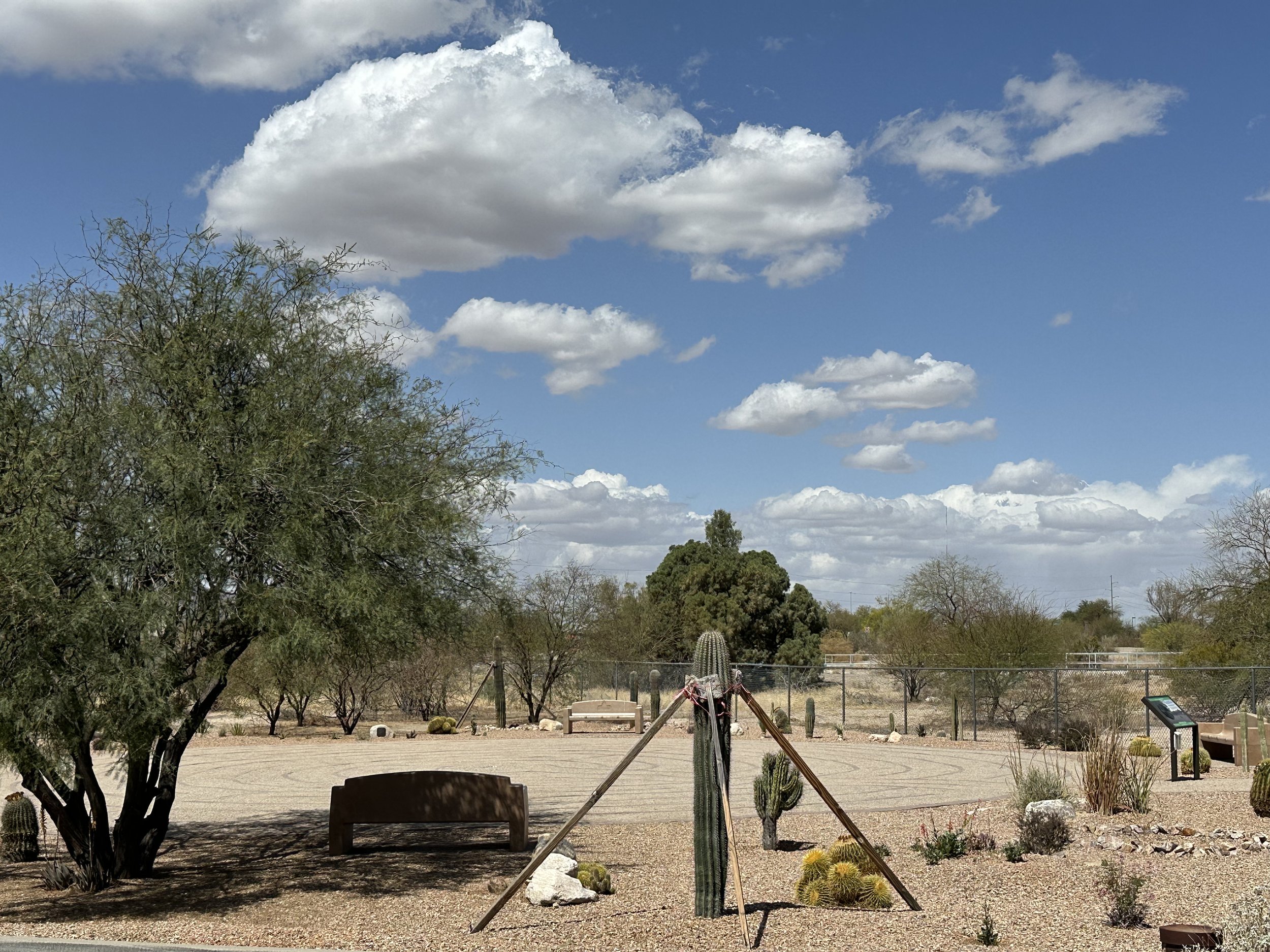
The Labyrinth
The Labyrinth at Pima Prickly Park
Labyrinths have appeared in different formats during their history of over 3,500 years. The theme of a single, winding path leading to a center that returns to the outside has been found in multiple variations in many cultures.
Photo credit: Eliseau Cavalcante
-
The labyrinth at Pima Prickly Park is a medieval-style pattern based on the labyrinth inside the Chartres Cathedral in France. That labyrinth was likely built in the early13th century and is constructed of limestone. Both of these labyrinths consist of 11 concentric circuits.
The labyrinth served as a safe metaphorical path of pilgrimage during the 13th century when the Crusades made traveling to sacred destinations too treacherous. Determined and creative, would-be pilgrims used the path within the safety of the church.
The labyrinth at Pima Prickly Park is constructed of a three- inch base of decomposed granite to provide a stable, porous surface. To provide an easy-to-navigate surface for visitors using wheelchairs, the paths are 30 inches wide and consist of an additional 2-1/2 inches of decomposed granite that is compacted and level with the pavers lining circuits.
The transformation of an unused, overlooked triangular-shaped tract of the park began in October 2022 when the Tucson Cactus and Succulent Society approved the project and a study group was formed soon after. The path leading to the labyrinth and the labyrinth itself were constructed almost entirely by the members of the Tucson Cactus and Succulent Society who volunteered their time, tools, creativity, and energy to make this project a reality. Concrete work at the top of the path and crosswalk painting were completed by the Pima County Natural Resources, Parks and Recreation. NRPR also provided two of the benches.
You will likely notice sea glass and other small objects at the center of the labyrinth at Pima Prickly Park. These are offerings people have left to symbolize the letting go of something, an expression of appreciation or remembrance, or an acknowledgement of an intention.
The reasons for walking labyrinths have expanded to include self-discovery, healing, contemplation, revelation, relaxation, and other stress reduction- related exercises to quiet the mind during these often turbulent, fast-paced times of the twenty-first century.
the construction of the labyrinth and path were completed in January 2024.
Artichoke Agave (Agave parryi)
Variegated Saguaro (rare)
Lady Slipper (Euphorbia lomelii, Pedilanthus macrocarpus)
Candelilla (Euphorbia antisyphilitica)
California Fuchsia (Epilobium canum)
Desert Zinnia (Zinnia acerosa
Red Yucca (Hesperaloe parviflora)
Wendy Emu Bush (Eremophila maculata ‘Wendy’)
Firecracker Penstemon (Penstemon eatonii)
Mexican Bird of Paradise (Caesalpinia pulcherrima)
Yellow Bells (Tecoma stans)
Aloe spp.
Autumn Sage (Salvia greggii)
Red Bird of Paradise (Caesalpinia pulcherrima)
Desert Spoon (Dasylirion wheeleri)
Shrubby Senna (Senna wislizeni)
Baja Fairy Duster (Calliandra californica)
Golden Dysodia (Thymophylla pentachaeta)
Chuparosa (Justicia Californica)
Ferocactus spp.
Golden Barrel (Kroenleinia grusonii)
Saguaro (Carnegiea gigantea)
Native Velvet Mesquite (Prosopis velutina)
Artichoke Agave (Agave parryi)
Some of the plants at the Labyrinth
Golden Barrel (Kroenleinia grusonii)
Types of Labyrinths
-

CLASSICAL
This is the initial format which appeared on coins and pottery in the area of Europe and Africa near the Mediterranean Sea. The “man in the maze” is a classical style labyrinth that is a symbol of the Tohono O’odham Indians belief in life, death, and life after death.
-

ROMAN
The Roman labyrinths were primarily mosaic pavement laid in the floors of bathhouses and homes of the wealthy for decorative purposes; they were too small to actually be walked upon.
-

MEDIEVAL
The eleven-circuit design that is familiar to us today was developed in the ninth century. This popular pattern was constructed in several churches and cathedrals in Europe.
-

CONTEMPORARY
Labyrinths have renewed popularity in the late twentieth and early twenty-first centuries as people seem to be striving to find a way to lead a more balanced, mindful, and productive lifestyle.





